
Related
Guests
- Steve Kurtzprofessor of visual studies at SUNY, Buffalo and a founding member of the award-winning art and theater group, Critical Art Ensemble. In May 2004, he was accused of bioterrorism and later charged with mail and wire fraud. He was cleared of all charges in April of this year.
In his first broadcast interview, Steve Kurtz discusses the bizarre case of how he became the focus of an FBI bioterrorism investigation. On May 11, 2004, his wife Hope Kurtz tragically died in her sleep. When he called 911 for help, a nightmare that would last for the next four years began to unfold. The police became suspicious of his art supplies and harmless bacteria cultures that he was using for an antiwar project about the public health impact of germ warfare programs. His home was raided by the FBI, the Joint Terrorism Task Force and Homeland Security. His belongings, his cat, and even his wife’s body were seized. [includes rush transcript]
Transcript
AMY GOODMAN: We turn now to our next story, almost unfathomable, but true, about art in a time of terror. Even Kafka might have had trouble conjuring up this one.
Steve Kurtz is a professor of visual studies at SUNY, Buffalo — that’s State University of New York, Buffalo — a founding member of the award-winning art and theater group, Critical Art Ensemble. On May 11, 2004, his wife Hope tragically died in her sleep. When he called 911 for help, a nightmare that would last for the next four years began to unfold.
The police became suspicious of his art supplies and harmless bacteria cultures that he was using for an antiwar project about the public health impact of germ warfare programs. Kurtz was detained as a suspected bioterrorist, his home raided by the FBI, the Joint Terrorism Task Force, Homeland Security. His belongings, his cat, even his wife’s body, were seized.
After a federal grand jury refused to charge Kurtz with bioterrorism, Kurtz and his colleague Robert Ferrell of the University of Pittsburgh Graduate School of Public Health were charged with federal mail and wire fraud concerning the acquisition of $256 of harmless bacteria. Under the PATRIOT Act, they could have faced up to twenty years in prison.
After four harrowing years, on April 21, a federal judge dismissed the government’s entire indictment against Kurtz as “insufficient on its face.” He’s been cleared of all charges.
Professor Kurtz joins us now from Rochester, New York, for his first broadcast interview. We welcome you to Democracy Now!
STEVE KURTZ: Thank you very much, Amy.
AMY GOODMAN: Why don’t you tell us your story, beginning that day, May 11, 2004?
STEVE KURTZ: Well, that was a very dark day for me. I woke up that morning and found that my wife had died in her sleep. And kind of after a moment of shock that slowly broke into a kind of panic, I made my way to the telephone, called 911. They came quite rapidly. And as they looked around, they did as they had to do when a woman who, quite young at this age, forty-five, dies in their home and called the police. And the police came out and secured my home, and then three detectives showed up. And for the rest of that day, I was pretty much interrogated as a murder suspect.
And one of the things that caught the police attention’s eye was my home lab, which was filled with pretty basic innocuous equipment that I primarily use for molecular biology, for DNA experiments. And they wondered why I had that, and I explained to them that I was a professor at UB, University of Buffalo, and that my specialty was the intersection between art and science, and this was part of the basic equipment I needed to have, that the university didn’t supply us studios, so we had to create our own space for it. And, you know, I showed them work I had done online, showed them my resume, showed them catalogs. But they weren’t particularly convinced by that, and they were more convinced by the idea that if someone has scientific equipment in their home that they’re probably up to something nefarious. And as the detectives left that afternoon, they were of the opinion that the FBI was going to want to talk to me.
So the following day, as I went out to go to the funeral home to make arrangements for my wife’s cremation, about three or four FBI cars came screeching up, and I was put into illegal detention and basically soft-rendered, meaning I didn’t have to get drugged and flown off to Guantanamo. It was much nicer than that. It was the pleasant way to get rendered. They take you to a hotel and hold you there without charge, without being Miranda-ized, and put you through a lighter style of interrogation.
I did have my phone. It was one thing I had with me, and I managed to call some of my friends. In fact, it was the Yes Men, who I think probably many of your viewers and listeners know. And they called the ACLU, who found a good lawyer for me. And the lawyer called me and said, you know, “Come down to my office.” I said, “I can’t. I’m apparently in detention, and I can’t leave FBI headquarters.” And he said, “Well, let me talk to whoever is in charge.” And I said, “Fine.” So I handed off the phone to one of the agents, who took it away. And he came back — I don’t know — two or three minutes later, and the next thing I know I was on the street heading for my lawyer’s.
<p.And it’s been — it was, you know, quite a mess after that, because it had already turned into a media fiasco. My house was surrounded. And the FBI had scrambled five different offices. The Joint Terrorism Task Force was already flown into town. And so began kind of this week of them raiding my house and seizing materials and, you know, kind of press conference after press conference of “Once again, here in Buffalo, following the Lackawanna Six, we have the next homegrown terrorist.”
AMY GOODMAN: And that was the six Yemeni men who were taken. I think Buffalo has one of the largest FBI offices in the country, is that right? I remember this story well in 2004, because I happened to be speaking at the University of Buffalo right after your wife had died and you had been seized. And the people who were driving me wanted to take me past your house, because they said, “You’re not going to believe it. They’re talking about the professor as a bioterrorist, yet the FBI has all these pizza boxes that are piling up outside, because they’re eating pizza inside the apartment — the house.”
STEVE KURTZ: That’s true. Yeah, they did leave us quite a bit of trash behind, between the wetware from the testing that was bundled up and left all over my home to the piles of trash left outside, primarily consisting of Gatorade bottles and pizza boxes.
AMY GOODMAN: So the word gets out that you may be a bioterrorist. Explain then what transpired from mid-May 2004 until, well, four years later, until just recently, when you were exonerated, what you ended up being charged with. You were brought before a grand jury?
STEVE KURTZ: No. Well, this is one of the amazing things. I think I deserve some type of degree in law after going through it, especially since it’s four years. You know, I don’t know what kind of degree, but something. And, no, I was never brought before a grand jury. If you’re a target of a grand jury, they tend to not bring you in. You know, they might bring in subjects that surround you and then other witnesses. So I have no real idea what happened in the grand jury, and nobody does. The transcripts are very rarely released.
But in the end, from what we can tell of people we know who were witnesses, although most of them took the Fifth, which one should always do when going in front of a grand jury, from what we can tell from the witnesses that came in, they were really trying to go for a bioterrorism charge, but the grand jury didn’t buy it, which is really odd, because there’s basically no rules for the prosecutor when he’s in front of a grand jury. This is why you get the famous aphorism of “a grand jury could indict a ham sandwich,” because the prosecutor does not have to show exculpatory evidence, there is no judge there, there is no defense there, they can bring in hearsay. I mean, they basically can make it up as they go along.
But I was not charged with bioterrorism, thankfully, and instead I was charged in the “go to” law, which is generally used in cases of activists on one side and organized crime on the other, and that is mail and wire fraud. It’s the most broadly written law on the books, and, as I said, it’s the “go to” one. When nothing else seems to be working, you can usually go to this one, because it is so vague, there’s always some way you can charge someone with it. And that, I did get charged with.
AMY GOODMAN: We’re talking to Steve Kurtz. Steve, are you still a professor at the State University of New York, Buffalo?
STEVE KURTZ: Yes, I am still a professor. And, you know, my hat’s off to my university. They did not bow to Department of Justice and FBI pressure to fire me. They kept me on. They presumed I was innocent until proven guilty. So I’m still there and happy to be there.
AMY GOODMAN: When we come back, we’re going to play some clips from a film called Strange Culture about the case of Professor Steve Kurtz. Stay with us.
[break]
AMY GOODMAN:
As we talk about the case, just concluded, of Professor Steve Kurtz, a professor of visual studies at the State University of New York, Buffalo — at first, it looked like he would be charged with bioterrorism. Remarkably enough, it was May 11, 2004, that his wife Hope died of a heart attack at the age of forty-five in bed. He found her, he called 911, and everything unfolded from that. Well, Strange Culture is a film based on Professor Kurtz’s ordeal. It’s made by Lynn Hershman Leeson, released by Docurama Films. I want to play a few excerpts from the film that feature Professor Kurtz’s friends and colleagues in the art world, describing the significance of his case.
GREGG BORDOWITZ: At the very beginning of this, I thought, like many other of my colleagues and friends, that here was a clear case where the FBI just doesn’t know what’s happening in the art world, and they see this kind of art, and they’re unexposed to it, and they are frightened by what they see, and that there would be a learning curve and that once the FBI realized that the Critical Art Ensemble were in fact not terrorists, that the case would just go away. I think the government, the FBI, the DA saw on opportunity to establish precedent in a way that they could extend the government’s powers into the university system, into academia, into the art world. They saw an opportunity, and they ran with it.
STEVE DIETZ: If an artist is silenced, then the potential is for everyone to be silent. Robert Ferrell, who is the scientist who was working with Steve, bought and mailed some of the agents Steve used, and that was done without a formal requisitioning process.
PAUL VANOUSE: I think it’s the first time this has ever happened in the history of federal court, where somebody is being charged for fraud, but no party feels defrauded, so neither the University of Pittsburgh nor the company that was shipping them the items felt defrauded. All felt this is a way that science is done. People are shipping things around, they’re borrowing things, especially in the university. The idea is that this is a sharing place of knowledge. And especially amongst university professionals, that was seen as being the only way that projects like the human genome project could even get finished.
BEATRIZ DA COSTA: We knew we were not bioterrorists. We had nothing dangerous in the house. And that feeling lasted for quite awhile, that soon it would all be over.
UNIDENTIFIED: This is not uncharacteristic of these cases, where they will first investigate them for something that they’re calling terrorism, and then when it goes through their whole process, it’s for some other charge.
GREGG BORDOWITZ: The body of Steve’s work is a growing body of evidence against the ways that the government, the military, science and industry often collude against the public good. And this is primarily why he is being focused on, this is why he’s seen as a good target.
AMY GOODMAN:
An excerpt of the film Strange Culture. I want to turn to another clip now. This features the actor Peter Coyote reading a statement of Robert Ferrell, a very well-respected geneticist, head of the Department of Genetics, former head of the Department of Genetics of the University of Pittsburgh Graduate School of Public Health.
PETER COYOTE:
[reading Robert Ferrell] From the beginning of the whole affair, I felt that I was simply collateral damage. From the start, the FBI seemed to have been interested in Steve’s politics. I got the impression that they were against the activities of the Art Ensemble and Steve, and this was a way to get him. Steve has an idea that they want to frighten anyone, including scientists, who question what goes on in this country.
I don’t think I did anything wrong. I would do the same thing again with Steve or anyone, if they wanted reagents and they were serious people that convinced me that they were doing all this for educational reasons. That’s the whole point, to educate the public about what is going on in science today. If I’ve broken any laws as far as Steve is concerned, I’ve broken it a thousand times, because I’ve had many people in my lab to learn these techniques and given biological reagents to many students to work with.
Genetically modified foods inserts genes from one kind of plant or animal into another using viruses as a carrier. We have no idea what the long-term repercussions of these transplants are going to be. Genetically modified foods are not labeled. You can’t go into a supermarket and find out that the milk you’re drinking has bovine growth hormone in it or that the tortillas you’re buying are made with genetically modified corn or that the soy you’re buying has been made with genetically modified soy. So all the citizens of the United States have been turned into unwitting, experimental victims of a mass-marketing industrial phenomenon, which has no regard whatsoever for their health, whose regard is basically about increasing wealth for shareholders and increasing the viability of the corporations and increasing the lock on the food supply of the corporations.
The choice of whether to consume genetically modified crops is everyone’s to make for themselves. The agribusiness has introduced these products into the food chain without people being aware of it. It has all happened with the government’s tacit approval, because they have not informed people what was happening. I guess they didn’t want me and Steve to make anyone aware of this, either.
AMY GOODMAN:
The actor Peter Coyote reading the words of Robert Ferrell, a respected geneticist, a former head of the Department of Genetics at the University of Pittsburgh Graduate School of Public Health. Steve Kurtz, what happened with Robert Ferrell? You were both charged with mail fraud.
STEVE KURTZ:
We were both charged, and, well, part of that was in order to get the charge. They had to show some kind of conspiracy between he and I. Unfortunately, what the FBI often looks for is to pick on the poorest, most vulnerable people, which are usually just that, financially very poor, often minorities, in these type of cases. But in Bob and I, they found two people ripe for the plucking, where they could say, “Well you know, we don’t always pick on people of Middle Eastern descent.” And the reason that it was good for them to kind of come for us, one, they thought here’s a person, very emotionally distraught, just lost his wife; there’s no way he’s going to be able to mount any kind of defense. And for Robert Ferrell, who was about to go in for cancer treatment, they’re like, here’s another one. Here is an older gentleman, quite ill, and what kind of defense is he going to be able to mount? So these are kind of two victims ripe for the plucking.
And the pressure on Bob was — really turned out to be too much in the end, and he suffered a number of strokes —- one was pretty serious, that he had to have rehab for, while he was going through cancer treatment for Non-Hodgkins. So in the end, he kind of had to throw in the towel, and he pled to a lesser charge, pled to a misdemeanor. The judge gave him the lightest possible sentence, I’m happy to say, and he had to step out. But I was of the opinion -—
AMY GOODMAN:
And explain — go ahead.
STEVE KURTZ:
Go ahead.
AMY GOODMAN:
You were of the opinion…
STEVE KURTZ:
Well, I was of the opinion, there was no way I was ever going to plead, or there was no way I was going to step out, because I just was refusing to let them set this precedent.
AMY GOODMAN:
Now —
STEVE KURTZ:
But I did have the resources behind me to fight this, and I was going to use them to the very end.
AMY GOODMAN:
And this had to do with Professor Ferrell mailing you bacteria for your art project, for your art display —
STEVE KURTZ:
That’s right.
AMY GOODMAN:
— something that is done very frequently, how often in this country?
STEVE KURTZ:
Oh, well, it’s done all the time. You know, scientists call one another quite frequently and say, “I need you to take a look at this. I’m sending you this sample.” It’s just how research works. So, yeah, there was nothing unusual about it. He never thought twice about it. And Bob and I had been working together for five years. He had given me all kinds of materials, reagents and non-pathogenic living organisms. So, you know, why would either of us have thought a thing about it while we ordered it?
But, you know, the FBI came in and the Department of Justice, and they had a much different opinion. And what they tried to base their case on was a material transfer agreement, which, at best, even if we broke it, which apparently we did not, but even if we broke a material transfer agreement, the worst that should happen would be a civil case in which the supplier should have sued us and asked for their product back.
AMY GOODMAN:
And the supplier was?
STEVE KURTZ:
The supplier was American Type Culture Collection. And they did not do so. And since it came through the University of Pittsburgh, they could have also sued us and asked for the product back. The University of Pittsburgh declined, as well, and said, “As far as we can see, no crime here or necessary lawsuit is here.”
AMY GOODMAN:
I want to turn to a last clip of the film, Strange Culture, that deals with the invitation to your exhibit. The invitation had some Arabic writing on it.
NATO THOMPSON: I believe they used the Arabic that Atlas Group used, which is a group that explores the history of Lebanon, that was on the cover of the exhibition announcement, as enough proof to come to the opening and serve subpoenas. That is so wild that one could just use Arabic on any text in order to prove some sort of intent or ability to serve subpoenas. I had no idea that that would be the use of that actual exhibition announcement.
AMY GOODMAN:
That clip from Strange Culture. You can find out more about the film at strangeculture.net. Steve, we only have two more minutes, but he’s talking about the invitation to your art exhibit that was supposed to be at the Massachusetts Museum of Contemporary Art, the invitation they picked up in your house that day when your wife died.
STEVE KURTZ:
Right. Yeah, that was a very odd thing that they used that to help to get the warrant. And when the prosecutor was questioned about it in the first hearing, the judge asked, “You mean if he had a Koran in his house, you would have confiscated that and used that in this manner?” And the prosecutor said, “Yes.” So, really, it’s quite disturbing how these pieces of, quote, “evidence” are being used and really for basically railroading people.
AMY GOODMAN:
Steve Kurtz, talk about the significance of your case, this four-year horror that unfolded from that night when your wife Hope died in bed.
STEVE KURTZ:
Well, it was terribly horrible for me, but, you know, what we were most worried about and why I wanted to fight this case to the end was this precedent, as we were talking about earlier. What should have been at best a civil suit, and it wasn’t even that, the Department of Justice wanted to be able to say, “You know, whenever there’s a contract dispute that involves the mail or internet” — and what contract dispute doesn’t? — “we’re going to have the right to come in and decide whether or not it’s a civil case or, if we wanted to be, however arbitrary, a criminal case. And then we are going to prosecute it as a criminal case, and thanks to the PATRIOT Act, this mail fraud case is now worth twenty years in jail.” So, you know, if you filled out a warranty card wrong and mailed it in, that could now be a twenty-year jail sentence. That’s what they were after, and happily the judge ruled against them and said this is an abuse of the law and that mail fraud cannot be used this way. So the precedent went our way and narrowed the law instead of expanding it.
AMY GOODMAN:
Are you continuing to do Critical Art exhibits around the world?
STEVE KURTZ:
Oh, absolutely. We’re more motivated than ever. So, yeah, it didn’t take anything away from us. In fact, when they took our work and tried to stop us from doing the work we were doing, it only made us more motivated, more aggravated and more determined.
AMY GOODMAN:
Steve Kurtz, I want to thank you very much for being with us, professor of visual studies at SUNY.

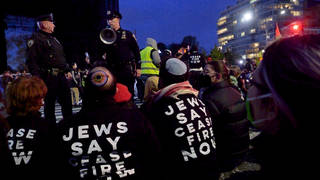
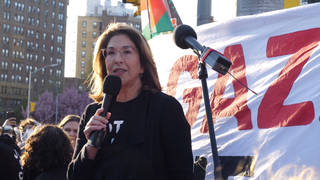
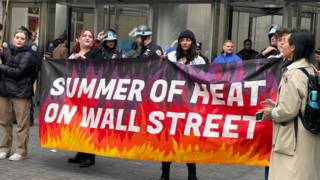
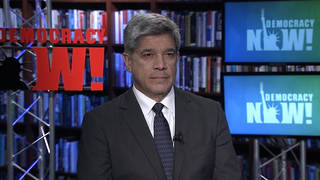






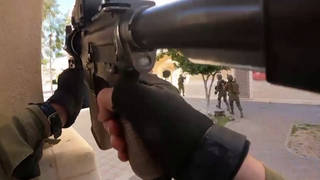
Media Options